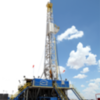I am very glad that none of you work for the Oklahoma Department of Environmental Quality or the Oklahoma Corporation Commission.
There are several well sites inside our city limits. Children can play right up to the 30 by 30 plot of land immediately adjacent to the well hole. In town at least, these sites have chain link fence around the pump jack (those rocking horse like structures that remain AFTER the well has been drilled, quietly and efficiently pumping oil to the surface. The actual motor driving said pump jack can be propane or "raw natural gas" powered or it can and often is an electric motor.
If there is enough oil on the ground that it is visible from 200 feet away, some land owner will be calling the Corporation Commission and that will cause some oil field a large fine.
Even in the early 1960s when we moved to Osage County Oklahoma (a move of a whole 7 miles from downtown Ponca City, Kay County Oklahoma) onto the 160 acre small cattle and horse ranch my dad bought. They drilled 4 wells on our 160 acres. The Osage Nation got all the mineral rights. (They were smart when they signed the treaty...all minerals below 18 inches are property of the tribe.) The Osage Nation would issue their own fines. IN ADDITION in many cases to the fines from the Oklahoma Corporation Commission.
Dad got the contract job to pump the wells and tank batteries on our place and about 3 other companies locations within about 3 miles of our place. Around 20 wells as I recall. He visited each of the sites daily. If a cow could stick its neck thru the fence and get ANY oil by licking the ground or eating grass, dad called the maintenance and service crews to repair the leak or other source for the oil and then to clean up the ground.
If you think there is oil on the ground, you must be modeling the 1920s, perhaps the 30s. After that, oil was expensive enough that no well lease site would have standing oil and few would have visible evidence of spillage. Oil may have only been $5 per barrel but milk was 50 cents a gallon and gasoline was around 20 cents a gallon as late as 1965 when I started driving.
NO ONE wasted the resource intentionally.
Can you find some nasty looking places in photos? I am sure you can. But I can promise you that I had more problems with my mom when I walked across the barn lot than when I went with Dad to service the wells and gauge the tank battery in the morning.
Such "cleanliness" had very little to do with the environment or messy working conditions. It had everything to do with money. Oil on the ground was wasted money. And IF a cow, goat, horse, sheep, hog, chicken happened to die...the oil production company paid.
Just a quick geography lesson. Osage County is the largest county in Oklahoma in terms of area. No so large in population. Get a map of Oklahoma. Osage County stretches from Ponca City OK (birthplace of Conoco) on the west to Bartlesville OK on the east (birthplace of Phillips 66). The Kansas state line was the northern boundary of Osage County and the Arkansas River was the southern boundary. (Adjacent to Tulsa, OK, for years nicknamed Oil Capital of the World.)
And if your lovely wife enjoys the "Pioneer Woman", the star Ree Drummond lives on and films her shows on the historic Drummond Ranch in...come on, you can say it with me, beautiful, scenic and historic...Osage County Oklahoma.
And you just thought we played football and had earthquakes.
=========================
If you want an oil well pump site to look realistic, it depends on the era. From the mid 40s until early 60s, bare dirt about 10-20ft around any oilfield structure (well head, pump jack, heater-treater or other processing tower and tank battery. By the mid 60s, small retention dams started showing up around tank batteries, but nothing that would "high center" a pick up truck or a well pulling unit (imagine a "derrick" on the back of a 10 wheel 2.5 ton truck to "pull" the pipe or sucker rod out of the well to work on the submersible pump at the bottom of the well. The pump attached to the sucker rod inside the "casing" pipe.)
Modern well sites that are "currently producing" usually have a nice gravel surface covering about a half acre or more if the tank battery was truck serviced or served multiple well sites.
Our well sites had gravel roads because our oil was transported out of the tank by an 18 wheel semi pulling 10,000 gallons of crude oil. We had one tank battery on our land that collected from 6 wells (two not on our property). The "lease" south of our property could only be reached by driving across our property...Dad made some money for that AND got the job pumping those wells. That company had more wells, but because of the geography, you had to reach the wells on three different roads but on different sides of the canyon-valley and ravines because none were simple to bridge. So Dad managed 4 batteries for that company and pumped around 12 well sites.














